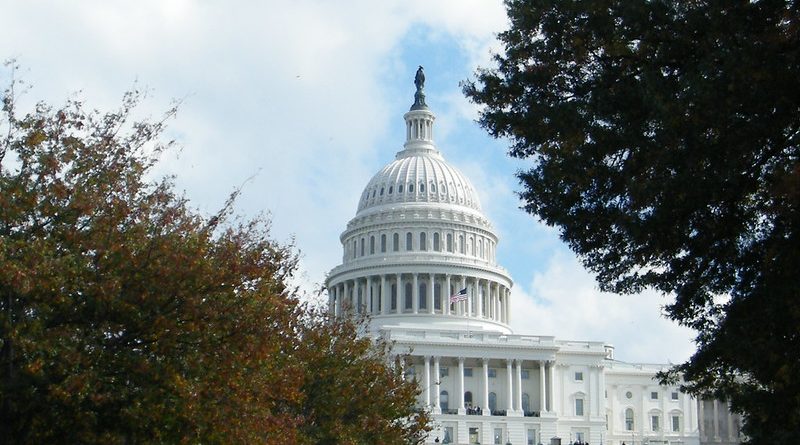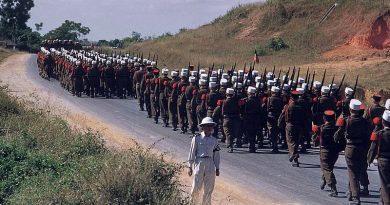The American War Of Independence
British Rule
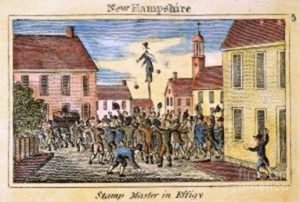
The Stamp Act Protest, 1765 by Granger
The brutal and bloody eight-year struggle between the British Empire and the newly-declared United States of America, which comprised the American War of Independence represented a key turning point in world history, seeing the world’s most powerful entity lose an unprecedented amount of power and territory. Indeed, prior to the explosive conflict, tensions between the British and their American subjects were long-simmering. This had a number of underlying causes, the most notable of which was the heavy taxation incurred by the American colonies following the Seven-Year War with France, which had left Britain in financial debt.
Thus, the policy of tax imposition on British colonies was introduced in 1765 in the controversial Stamp Act. This was met with outrage by the American subjects, who had accumulated a great deal of wealth in the preceding years and perceived these new measures as unconstitutional, as they had no elective representatives in the British Parliament through which they were taxed. Indeed, these taxation issues would prove decisive in the intensifying conflict between the British and the Americans.
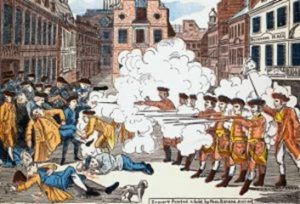
Boston Tea Party Massacre by Paul Revere
A pivotal development in the growing conflict between the British and the Americans, the Boston Tea Party was a protest against the heavy taxation recently imposed upon the colonies. Carried out by the Sons of Liberty, a secret society formed to protect the rights of the colonies, these activists boarded ships docked in Boston Harbour by the East India Company and destroyed the tea shipments by throwing them asunder. The Boston Tea Party is viewed as both a culmination of tensions between Britain and the Americas as well as a key catalyst for the American Revolution.
The British responded with punitive measures, crippling Boston’s economy through the Trade Act of 1774, which prevented trade from occurring within the region while also stripping Massachusetts of self-governing privileges. These, among others, were collectively known as the Coercive Acts, which were only met by increasing resistance from the colonies. This resistance grew increasingly sophisticated as the American Revolutionary War soon began.
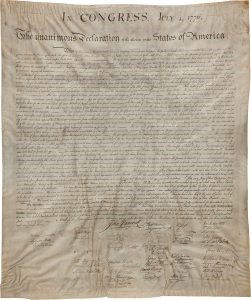
US Declaration of Independence 1823, Stone Printing
Declaration Of Independence
Composed in the midst of the War of Independence with the British, the Declaration of Independence was a statement issued by the Continental Congress, a collection of delegates from the Thirteen Colonies, which comprised the United States of America. Officially adopted on July 4, 1776 in Philadelphia, the Declaration of Independence announced the USA’s separation from the
British Empire and the beginnings of a new nation. Key figures in the composition of the Declaration of Independence were future American Presidents John Adams, who played a pivotal role in the drive for independence and Thomas Jefferson, who was selected by the committee to produce a draft of the Declaration. This would be amended by Adams and Benjamin Franklin, another future President. Printed and distributed to the general public, the document would go to resonate for hundreds of years after its inception, remaining a key feature of American cultural history.
Washington’s Role
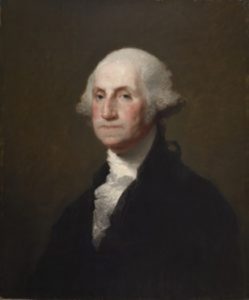
Walters Gilbert Stuart George Washington
Known as the United States of America’s first President, George Washington played a pivotal role in the conflict between the British and the Americans, serving as the latter’s military and political leader, appointed the titles of General and Commander-in-chief.
Born into a wealthy colonial family of tobacco farmers, he quickly ascended the ranks of the British military during the French and Indian War. Due to his military experience, patriotic values and political abilities, he was a natural Act and particularly the Intolerable Acts of 1774.
Upon the creation of the Continental Army in 1775, Washington was appointed its leader. He devised the American Revolution’s basic strategy in collusion with the Congress, vowing never to surrender and to continue fighting, despite losing a number of battles. He also trained and organised the American army, creating a sense of structure within the newly-established military force. He also provided a representative face of the Revolution, an embodiment of the ideal of resistance against the British, arguably his most important function of all.
His political manoeuvring allowed a number of different, potentially
unwieldy forces, such as the continental army, the congress and allies such as the French, motivated and co-operative towards the same goal. Amongst his most notable military
accomplishments were the Siege of Boston in 1776 wherein he ousted the British, the crossing of
the Delaware River, and the small yet pivotal Battle of Trenton, which boosted the Revolutionaries’
wavering morale and renewed a sense of inspiration amongst the soldiers.
Key Battles
Over the eight year conflict, there were several military engagements, some of which carried more significance than others. Arguably the most notable were the Battles of Lexington and Concord, which signified the beginning of the conflict between the British and the Americans.
With the colonial assembly having formed a provisional government-the Massachusetts Provincial Congress, the British interpreted this as a state of rebellion and thus assembled 700 troops in Boston under the command of Lieutenant Colonel Francis Smith. The Patriots however, having been informed of the British military’s movements, were prepared for this, and were able to plan an effective strategy to combat the British.
Despite initially being overwhelmed by the British, the Patriots managed to oust the British from North Bridge, causing them to retreat to the rest of the British forces. With a combined force of 1,700 men, they were forced into a tactical retreat as the Patriots prevented access to Charlestown and Boston, thus beginning the Siege of Boston.
Considered the beginning of outright military engagement between the two sides, the opening gunshot by the patriots was termed ‘The shot heard round the world’, indicative of the battle’s importance in the grand scheme of American, and even world history.
The Siege of Boston, which immediately followed the Battles of Lexington and Concord, was another key phase of conflict in the American War of Independence, lasting nearly an entire year from April 19, 1775 – March 17, 1776.
With the British Army’s movements by land restricted entirely to the city of Boston, a siege broke out. Although the British seized Bunker Hill in June, they suffered heavy casualties with over 1,150 dead or wounded in comparison to the 400 American casualties. They were also unable to make an impact on the British military’s control of Boston. A key turning point of the conflict came in November, when Commander-in-Chief Washington dispatched former bookseller Henry Knox to transport heavy artillery into Boston from Fort Ticonderoga.
Over a few months, the Continental Army were able to fortify the Dorchester Heights region with canons, thereby severely constricting the supply lifeline to the British. With no choice left, the British retreated from Boston to Halifax, Nova Scotia, marking a key and decisive American victory.
The Battle of Trenton in December 1776 was another key victory for the Colonial Americans despite being a small battle. With the British having exercised a period of military dominance previously, the Continental Army were forced into a state of retreat. With morale at an all-time low, Washington formulated a plan to cross the Delaware River, surrounding and overwhelming a garrison of Hessian soldiers, definitively defeating them.
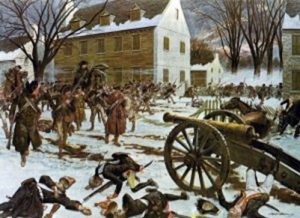
Battle of Trenton by Charles McBarron
Although there were less than 100 British casualties, the Battle of Trenton nonetheless proved to be a definitive turning point in the conflict, affording the Continental Army an inspirational morale boost, causing a huge influx of new recruits.
The Siege of Yorktown was another armed conflict of huge importance, signalling the end of the conflict as well as the height of co-operation between the Continental and French Armies. The last major land battle, it lasted nearly an entire month. With the French having arrived in Rhode Island in 1780, numbering 5,500, the two armies united near New York City in Summer 1781.
The British defence had weakened significantly in recent months as a result of American and French bombardments. The British, under the command of Lord Charles Cornwallis, found their situation spiralling further and further out of control, sustaining over 300 casualties. In addition, over 7,000 British soldiers were captured by the Americans and the French. Cornwallis was forced to surrender, the ceremony of which took place after two days of negotiation. While the conflict wasn’t entirely over, the siege of Yorktown signified the beginning of the end.
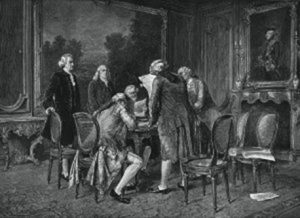
Signing of the preliminary Treaty of Paris, November 30, 1782
Victory
Following the Siege of Yorktown, American liberation was all but inevitable. While King George III pledged to continue the fight, the British Empire soon became preoccupied with conflict else whereas a number of Britain’s other colonies in the West Indies became threatened by French and Spanish forces. As a result, Parliament decided to call off all offensive operations in America and begin negotiations towards peace. While over 30,000 British soldiers remained in North America, in Savannah, New York City and Charleston, all land combat had ended. While naval conflict in the West Indies remained ongoing, peace gradually began to take form, culminating in the Treaty of Paris in 1783. Support for the war in Britain had fallen significantly since the Yorktown fiasco, with the House of Commons voting to cease all conflict once and for all in April 1782. After months of negotiations, the Treaty of Paris marked a formal end to conflict, with the United States attaining all North American territory between the Mississippi River and the Appalachian Mountains, which angered the First Nations and leading to further conflict in later years. Despite this, hostilities had, for the better part, ended, and the United States had formally been established.

